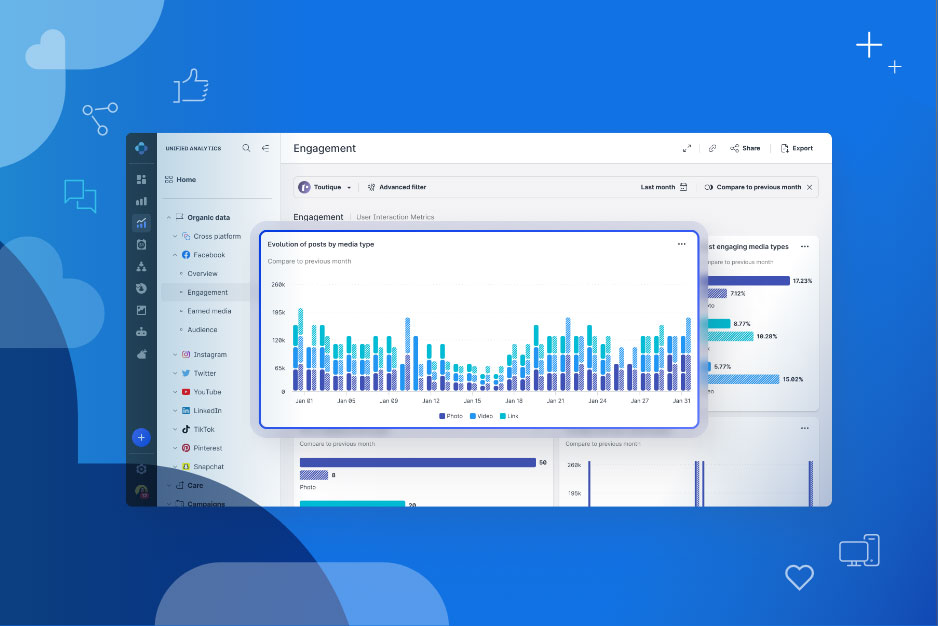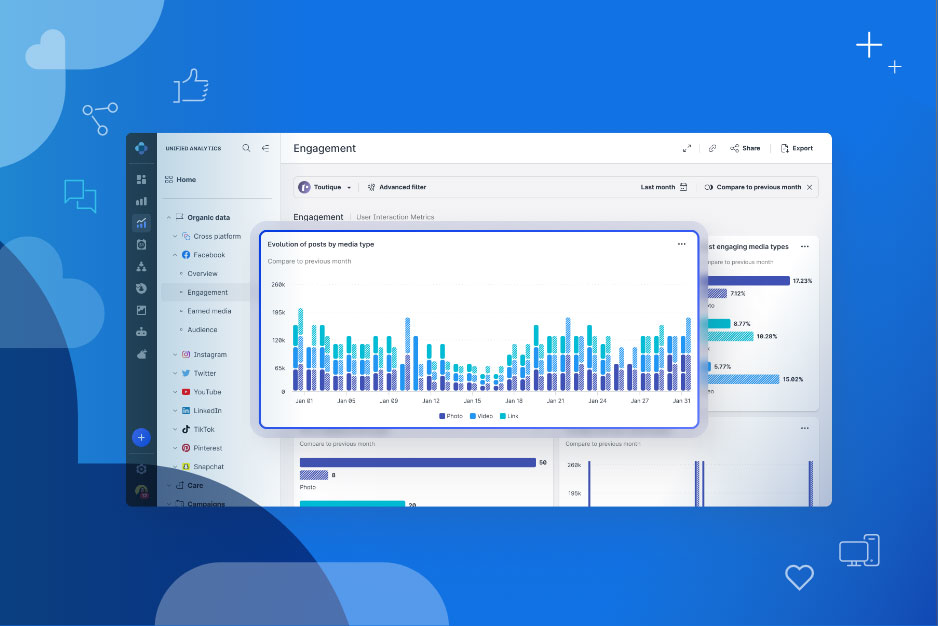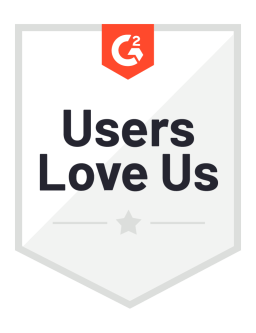Modern consumers have new expectations for how your brand engages with them across social and digital channels. They’re everywhere, and they expect you to be as well. They navigate seamlessly between searching, researching, shopping, selecting, and sharing, leaving a complex digital footprint that spans beyond social media.
Imagine a day in the life of such a customer: starting with a product search on Google, reading reviews on Facebook, watching related videos on YouTube, and finally making a purchase via an Instagram ad. Each of these actions generates valuable data that, when integrated, can provide a holistic view of customer behavior and preferences.
However, if you’re like most companies, this vital information is scattered across different platforms and tools. So, instead of one shared understanding of your customers, your teams across social media, commerce, and care only have one piece of the larger puzzle.
Many of our clients at Emplifi face this challenge, but it’s one that can be solved with a unified data analytics solution. You probably already have social media analytics tools, which is an excellent start to understanding your customers. But there’s a difference between a social media analytics tool and a unified data analytics tool like Emplifi Unified Analytics. And that difference is the ability to create actionable customer insights with a full 360-degree view of your target audience or persona.
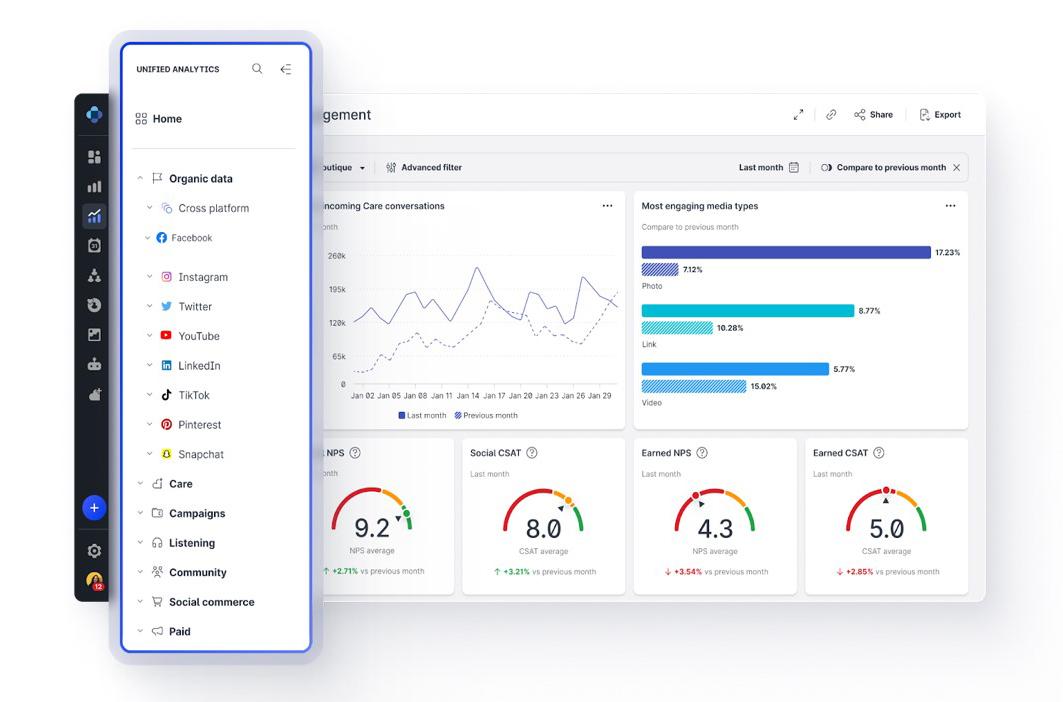
What role do social media analytics play in unified customer data?
Let’s consider the types of insights your brand can receive from social media analytics. By evaluating metrics such as likes, views, shares, comments, and clicks on social media channels like Facebook, Instagram, X, and TikTok, you can begin to understand your followers' preliminary preferences and behaviors.
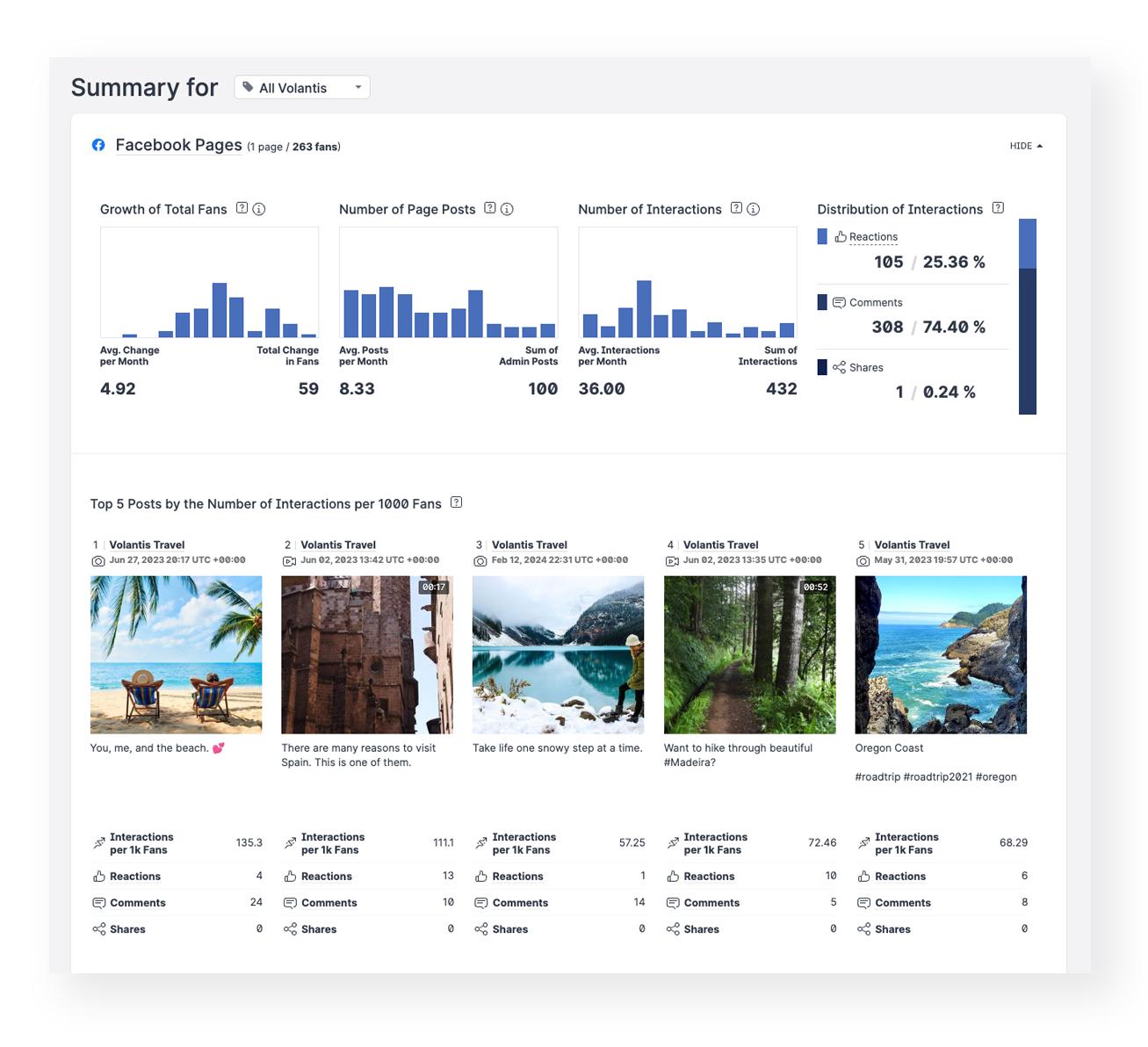
Source: Emplifi Social Media Analytics Dashboard
The shift from follower to customer is where a unified analytics tool delivers actionable insights — blending disparate social media and customer data from touchpoints across eCommerce and customer care. It’s one thing to bring that data together, and another to sort through it all.
The collection, sanitation, consolidation, and analysis of your social media data begins the process of understanding your audience. The key is to connect as many social profiles as possible to track any interactions you have with your customers. This is how you can start to benefit from unified data analytics.

Source: Emplifi Unified Analytics Engagement Dashboard
How do unified data analytics tools create actionable insights?
Data on its own is not insightful, and the more data you have from fractured sources and platforms, the harder it is to reach useful conclusions.
So, how does a tool like Emplifi Unified Analytics deliver actionable insights across your different teams? As mentioned earlier, discoveries by one group tend to inspire or support strategies within another team. That’s why it’s best to think of the data as a stream, and the first step is to connect your customer data across social media, commerce, and care into one river.
For Emplifi customers, this means connecting our different products under one analytics solution. The ability to link platforms that manage customer touchpoints improves your ability to orchestrate that data into a system for easier measurement and analysis. So, to continue the analogy, your teams need to swim in the same river. Here are three ways to do that.
1. Connect each of your brand social profiles and customer channels into one platform
Certainly, without the right structure, each of your teams can drown in data. This is why we’ve crafted the Emplifi platform to focus on a comprehensive, user-friendly, and practical approach to data management and interpretation. Each of your specialists across social media, eCommerce, and care must be able to collaborate and share insights they discover.
Once all of your data is fed into the same system, you’ll have the ability to make cross-functional insights, track customers along their entire journey, and react more quickly to trends. And don’t forget social listening, as that can help transition analysis into real-time action if caught early enough.
2. Create dashboards and reports with key metrics each team will track
This is where easy-to-use visuals are helpful. If your unified data analytics tool has a favorable user experience, you’ll be able to focus more on data analysis than on data sorting and sanitation.
Any dashboard, widget, module, or report created should map to your internal measurement strategy:
What are the touchpoints you’re able to track?
What are the key performance indicators (KPIs) within that channel?
Do you have specific growth goals, or are you simply trying to grow a digital community?
Your team – across social media, commerce, and care – must consider your customer journey, and what precisely you want to track.
Naturally, that process will evolve as you learn more. However, reviewing the same data and reports can help grow collaboration within your organization.
3. Test the real-time application of unified insights across a brand event
Here’s where actionable insights can come to life. There will be insights throughout the year, but once your system is in place, your teams can collaborate around big events or moments like Black Friday or a major product launch.
Here’s an example scenario to consider:
Your brand launches a new product line for the holiday season. You've done the forecasting, and the orders flow in as expected. Then something unexpected happens.
Your social listening tool detects a surge in mentions and engagement with one of the new products. It's become extremely popular among a key group of influencers, and Gen Z has even turned it into a viral TikTok trend.
It's a marketing dream come true, but sales haven’t spiked. If your customer data isn't connected, you might struggle to identify this disconnect and miss out on potential conversions. This is where unified data analytics connects opportunity and activation.
Your teams utilize a full picture of customer data to identify the gap. They quickly deploy shoppable social to channels with the highest mentions and then partner with influencers who authentically align with your message.
Sales start to climb, but there are additional opportunities. Your unified data presents insights from customer service, ratings and reviews, and emerging social trends that suggest more conversion opportunities. Real-time analysis leads to quicker decision-making to seize this opportunity.
Your social media and eCommerce teams now collect and share shoppable UGC that shows how multiple products work together. This sparks a new wave of interest and further accelerates sales.
With the right mix of customer data, quick analysis, and internal collaboration, unified data analytics can help put such a flow in place and, as a result, help spark similar results for your business.
Here’s how that could translate into tactics for actionable insights within a unified data analytics tool like Emplifi Unified Analytics.
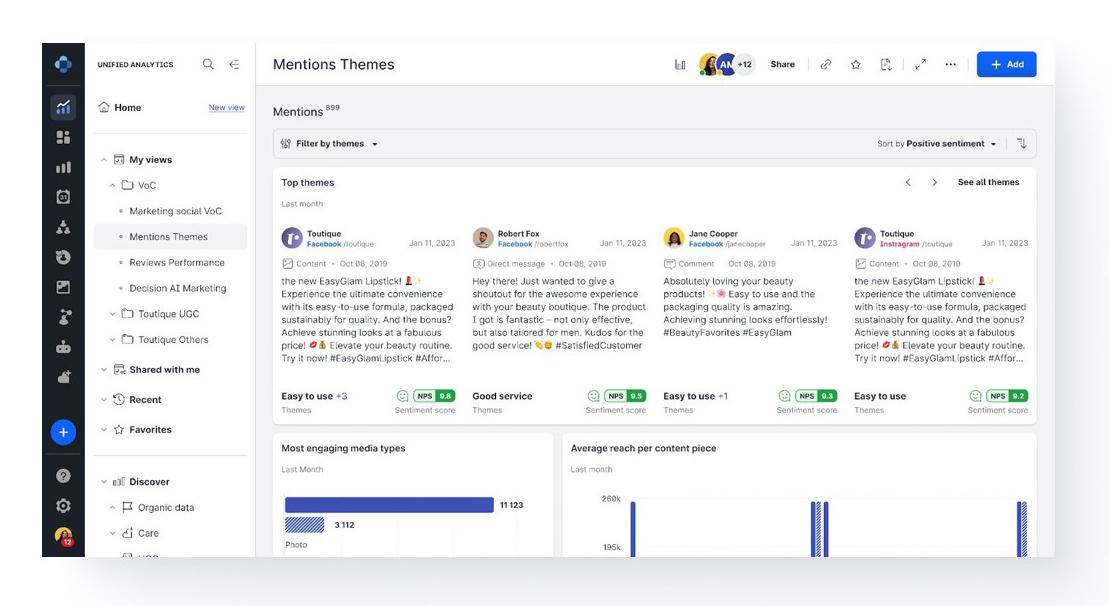
Source: Emplifi Unified Analytics Mentions Themes Dashboard
4. Establish social media listening topics to provide shared customer insights
Social media listening connected to Unified Analytics allows themes to emerge that can benefit your social marketing, social commerce, and customer care teams. This type of data shows you what customers really think away from your own brand channels, including:
What topics are they discussing?
Which influencers or brands are they interested in?
What content is going viral?
If your brand identifies trending topics within these themes, you’ll be better prepared to react quickly.
5. Setup spike alerts to draw attention to specific surges in customer activity
It pays to react quickly, and a spike alert with Unified Analytics will make sure your team reacts quickly to rapidly changing customer trends. This works best after establishing a social listening framework to understand what types of activity would cause either a positive opportunity or a crisis to manage. Any surge or spike is a moment to take action, and this is easier to do with linked customer data feeding into one view.
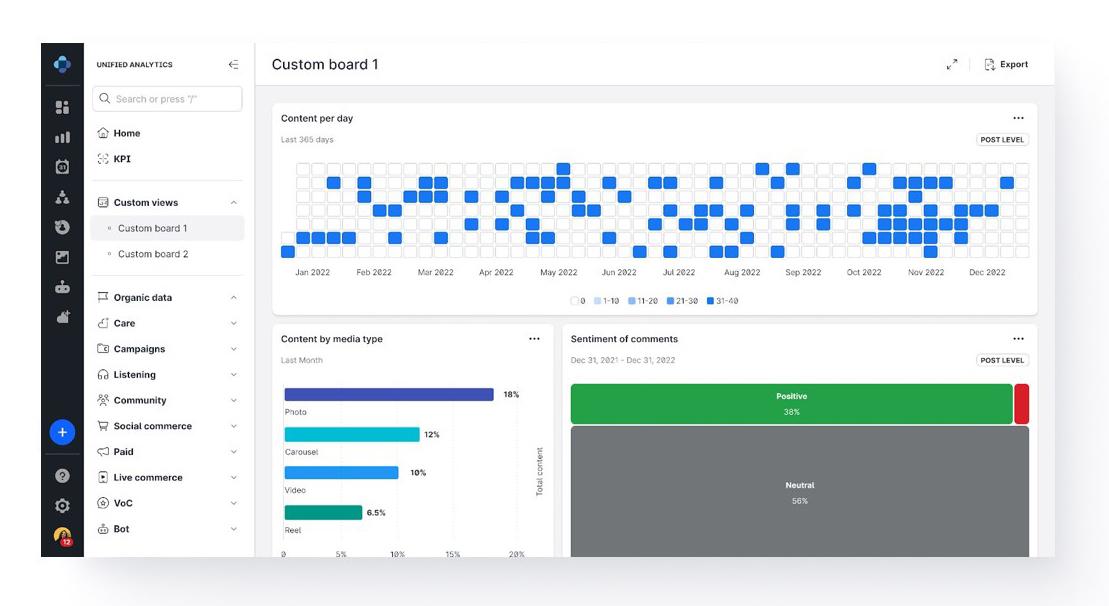
Source: Emplifi Unified Analytics Custom Dashboard
6. Evaluate head-to-head or time comparison views of your data
Examination of data over time through a head-to-head comparison or within a specific window of time is a foundational element of a unified data analytics platform. With Unified Analytics, you can tailor customizable widgets to view your customer data over specific windows.
This is the easy way to quickly visualize an opportunity or insights and create a shared action plan to respond. That could mean spikes in engagement around particular types of content or simply validating the success of your customer engagement plan.
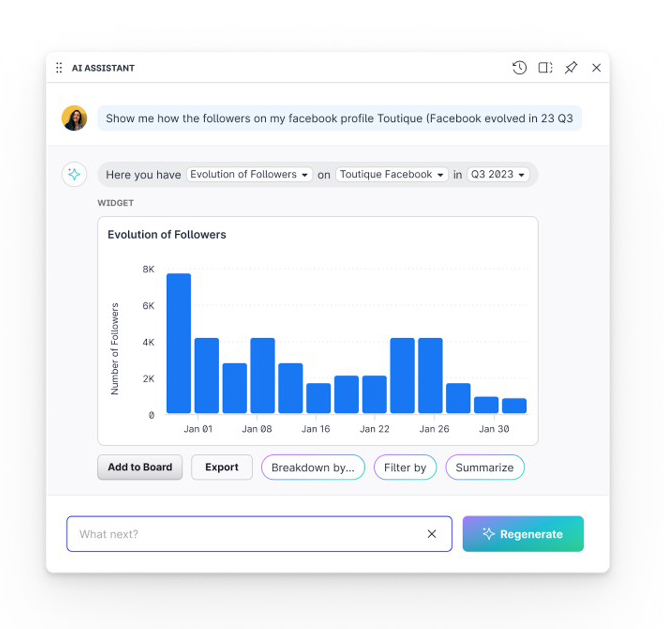
Source: Emplifi AI Assistant
7. Utilize AI and automation to speed action on data or insights
AI is now central to marketing, and working it into your process is a priority to keep pace with customer activity. Customers will move faster than you can react, so a system with AI or automation helps you stay ahead through data summarization, quick analysis, or simply streamlining key steps within your path to actionable insight.
How to share the benefits of a unified data analytics tool
It doesn’t hurt if the information you collect is easy to consume. A unified view of your customer data can be overwhelming, so an essential benefit of a unified data analytics tool is that it simplifies data analysis. In the Emplifi platform, that translates to user-friendly widgets, visualizations, interactive dashboards, and AI-powered search that presents complex data in a digestible format when you need it — all without needing deep technical knowledge.
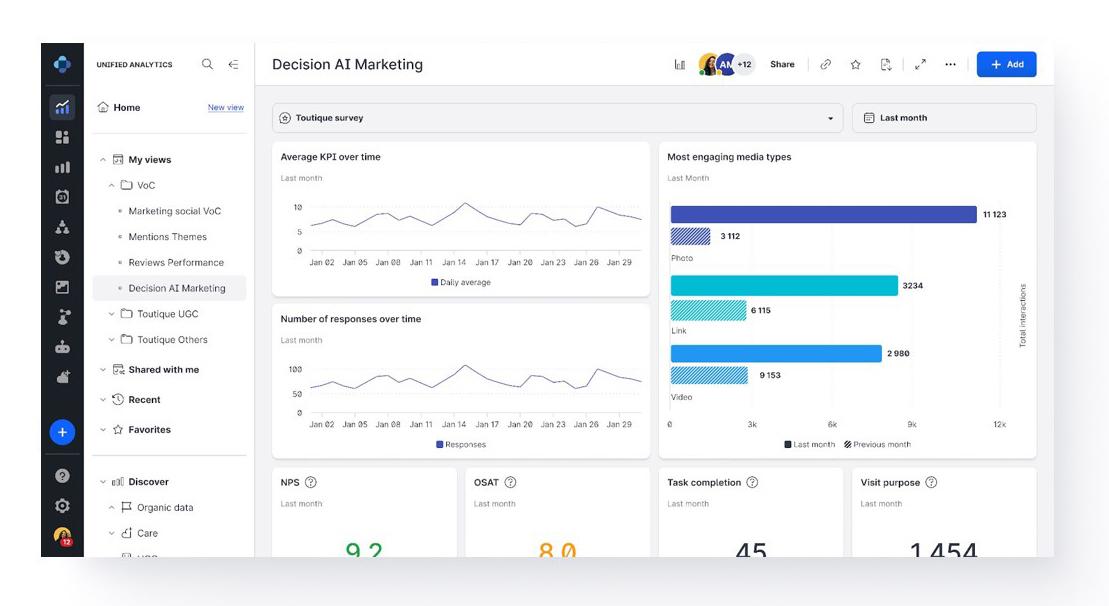
Source: Emplifi Unified Analytics AI Marketing Dashboard
Visuals alone aren’t enough, of course, and AI and automation can’t do everything for you. You have to find ways for the experts within your organization to share and collaborate on what insights you discover. What you learn about your customers really comes down to where you engage them. That’s why we think of our Unified Analytics as providing value across three distinct marketing departments: social marketing, commerce, and care.
In truth, each of these groups works together to create customer experiences, and that’s why access to shared insights and a 360-degree view of each customer is key to finding the benefit to your brand.
Here are three typical sources of customer data within Unified Analytics and how they work together:
1. Social marketing
Your social media teams are typically in a daily battle to define the role, benefits, and impact of social marketing on your organization. These teams have to keep a pulse on your target customers, the market, competitors, and what’s trending.
Social marketing teams, usually in partnership with digital marketing teams, track performance through the lens of social media engagement. These teams must collect, review, and connect audience insights to the rest of your buyer’s journey.
Social media is an ongoing conversation with your target audience, so likes, shares, comments, views, and clicks are indicators of audience taste. You can see trends through analysis of real-time and historical social media data. These insights can be shared to commerce and care teams to help your brand proactively anticipate shifts in customer behavior and adjust strategies quickly, making you less reactive and more strategic.
If there’s a surge in popularity around a particular piece of content, this likely serves as a connection point for your commerce teams. Similarly, if there’s a rise in negative sentiment around a particular topic or product, this social media activity can prepare your customer care teams to react or plan FAQs for a timely reaction.
2. eCommerce
Your eCommerce and social commerce teams aim to transform brand discovery on social into authentic, memorable, and shoppable experiences. This can mean layering on product tagging for shoppable social, amplifying high-performing social activity like user-generated content (UGC) across eCommerce channels, or iterating commerce strategies based on audience insights sourced from brand social media.
To do this, your teams need a deep understanding of the entire customer journey. This means everyone will look at shared data to identify key conversion points and optimize all interactions to turn interest into sales. This just means eCommerce teams can feed conversion data into your growing customer portrait.
By pinpointing the content, channels, and tactics that lead to conversion, you’ll better understand your customers and their journey.
3. Customer care and service
The key to effective customer care and service is to fully understand your brand’s interactions with that person. Nothing hurts the customer experience faster than slow response times or confusing or redundant case management. While your teams manage individual cases, it’s pivotal to have a unified view of all their feedback and interactions across social, digital, commerce, or any other point of origin.
Case management data paired with insights from social media and commerce activities can provide context for better customer interactions, as it allows brands — and agents, specifically — to anticipate customer needs, resolve issues faster, and contribute to customer retention and brand loyalty.
The path to actionable insights starts with unified data analytics
Just collecting data isn’t enough to keep pace with the modern consumer. You need a cohesive, actionable overview of your customer interactions across all platforms — not just social media — to enable your teams to anticipate market trends, adapt strategies in real-time, and track results aligned with business goals.
With Emplifi Unified Analytics, you’re not just collecting data, you’re actively leveraging it to forge stronger customer connections, enhance operations efficiency, and gain insight to predict and shape future outcomes through informed, data-driven strategies.
We’d love to help you turn information into action. Reach out to us to learn how to get started.













